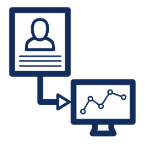How has COVID-19 impacted fraud rates?
We’ve witnessed a 10+ year bull market deteriorate in a matter of weeks as a result of COVID-19.
Short of the sun not rising and the world not spinning on its axis, it has felt pretty close to the end of time.
Now despite unemployment skyrocketing to historic highs and the entire human population self-isolating, while it feels like the world has stopped spinning, it hasn’t.
For us at ForMotiv, other than working from home business has largely stayed the same. Sure, our customer’s and prospects’ budgets have been cut, projects pushed back, and a general air of uncertainty looms, but in looking at our customer data we’re actually seeing something pretty interesting…
Volumes are up. WAY up.
Obviously, every customer is different and it largely depends on the product they’re selling, but in two of the sectors we work in, On-Demand Economy and Life Insurance, we’re seeing surges in application volumes.
As the newly unemployed population looks for a means of income, we’ve unsurprisingly seen applications for one of our on-demand food delivery businesses double. People still need to eat and someone needs to deliver that food. We’re working with them to ensure this rise in applications is not also met with a rise in fraudulent applications.
In the life insurance space, applications are surging as people who previously put off the decision to buy are now changing their minds.
“We are expecting that March could be our best month ever for both applications and policy sales,” Mark Sayre, head of risk solutions at online life insurance agency Haven Life, told Business Insider. Similarly, fellow online life insurance agency Fabric has reported 50% more applications than usual since February.
Not enough time has passed for us to analyze the other side of this unfortunate equation which is the number of death claims filed as a result of COVID-19, but we thought it might be interesting to see if there was any impact on fraud rates during times of financial unrest.
What can we learn from past recessions?
We’ve certainly seen a rise in scams out there with people pretending to be from the US Centers for Disease Control and Prevention or World Health Organization, asking recipients to click a link to report active infections in their area. Offer links to a fake daily newsletter for Covid-19 updates offers for fake insurance schemes and trading advice and pretending to be from the government, offering tax refunds
But aside from outright scams, as personal savings dwindle and falling profits push businesses toward bankruptcy and lower than expected earnings, many good American citizens and corporations could make bad decisions to get quick payouts through insurance scams.
It happened during the crash of 2008-2010 — waves of schemes surfaced by desperate Americans who lost their savings and saw no other way out. Vehicle torching, home or business arsons, and other insurance crimes rapidly spread.
Fraud calls rose 50% during that time frame.
In good times 1 in 4 millennials said they would lie on their mortgage application – imagine what they would do in bad times!
Back in 2008, Deloitte ran a survey that showed 63% of their clients expected an increase in fraud related to the financial crisis.
I mean, when you’re up against bankruptcy, losing your home or business, and throwing your family or employees on the street, rationalizing your fraudulent behavior might feel a little easier…
The other piece of this is similar to the saying, “When the tide goes out we will see who was swimming naked.” As the markets unravel and money is tight, businesses are forced to look into their own operations.
Hitesh Patel, a fraud-investigation partner for KPMG says, “Companies are restructuring, revising their strategies, trying to preserve their interest, their cash, their asset position, and because of looking at their businesses, they’re starting to find more fraud.”
Now it’s somewhat uncertain if this is a chicken or the egg scenario as it’s possible that there was a similar amount of fraud beforehand and when business is good, people don’t tend to question anomalies as thoroughly and small fraud might even be dismissed in an effort to maintain focus on growth.
Can’t do that when times are tough.
It goes back to the Fraud Triangle created by Donald Cressy that describes three factors present in every situation of fraud: Pressure, Rationalization, and Opportunity.
Pressure is an obvious one. The pressure to meet goals, fear of losing your job and a reduction in salary are just a few examples of reasons for committing fraud. I’d say there is plenty of pressure going around these days…
Rationalization we already somewhat discussed but putting your own problems ahead of your companies is often a driver that leads to a “my company can afford it” attitude. We tend to see more agent-related fraud during down economic cycles as their livelihoods are threatened.
And finally, opportunity. Fewer people doing more work leads to a lack of oversight coupled with the fact that middle managers (supervisors) tend to be the first employees cut.
The dramatic shift to working-from-home as a result of COVID-19 has created major challenges for companies that rely on a management system that usually requires walking around the call center. These (now) outdated methods of oversight need to be updated to reflect the changing work environment.
Using behavioral intelligence for digital oversight on your employees and agents, whether captive or independent, helps detect devious, anomalous, risky, or outright fraudulent behavior.
So what should businesses do?
For starters, review internal control policies and procedures. Removing opportunities by strengthening internal controls is a great first line of defense against fraud.
Second, monitor key metrics for anomalies. The closer you (or your behavioral intelligence solution) monitor your metrics the more likely it is you will spot anomalies. The better your approach to data science the better your insights.
Third, pay attention to your customer’s and employees’ behavior with solutions such as behavioral intelligence. By understanding both the past and present digital body language of your customers, agents, and employees, predicting devious and fraudulent behavior becomes much easier.
Interested in how ForMotiv can help reduce fraud? Email us at info@formotiv.com








